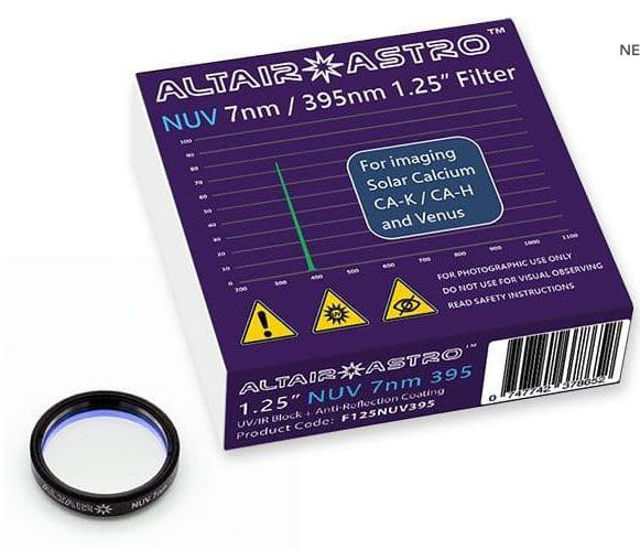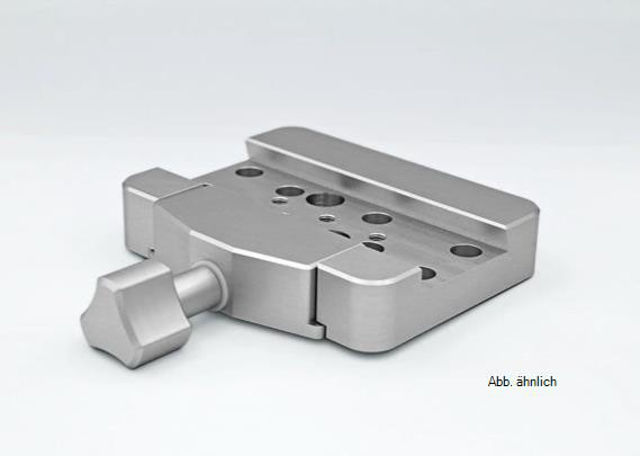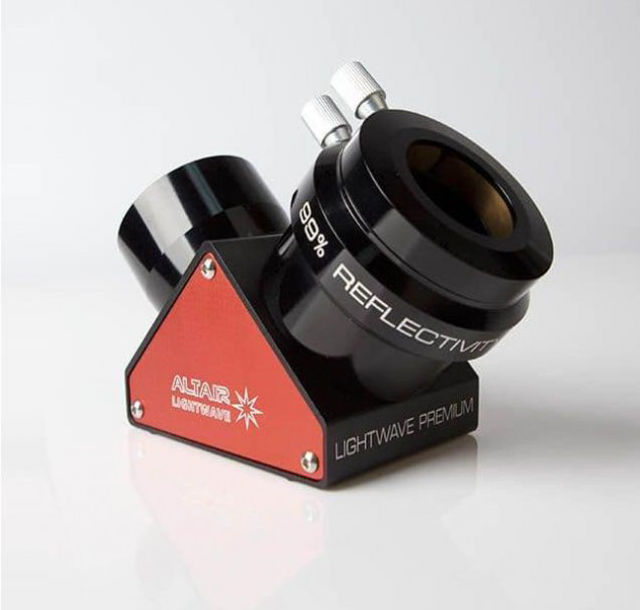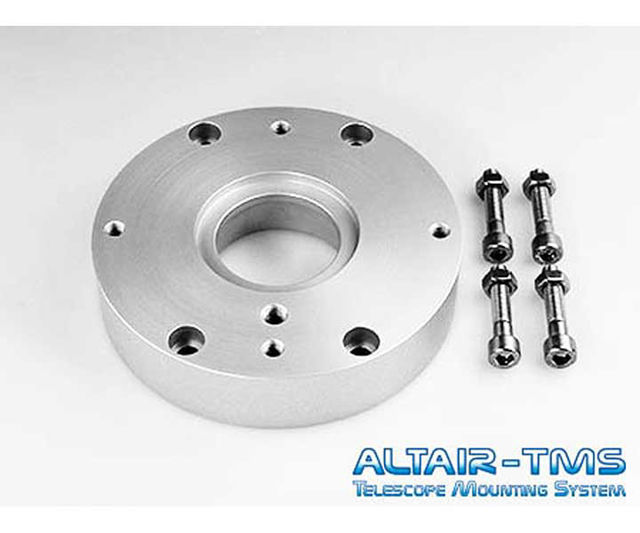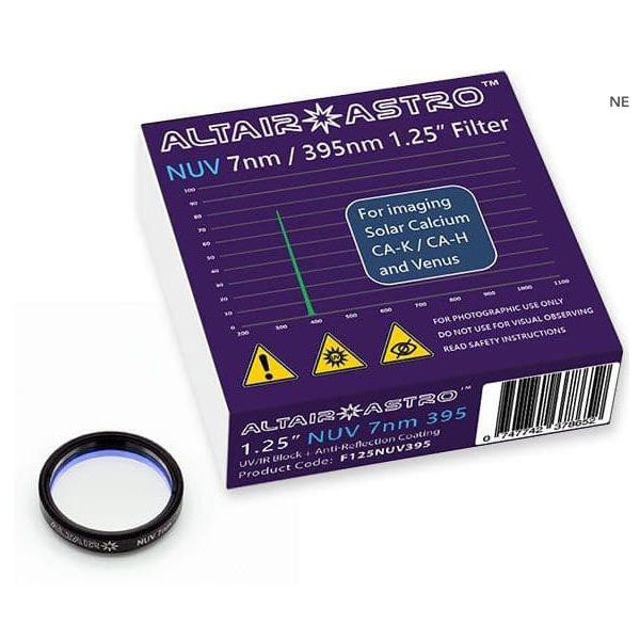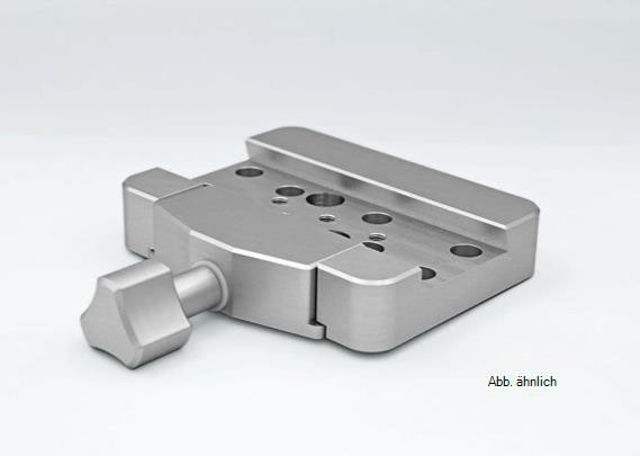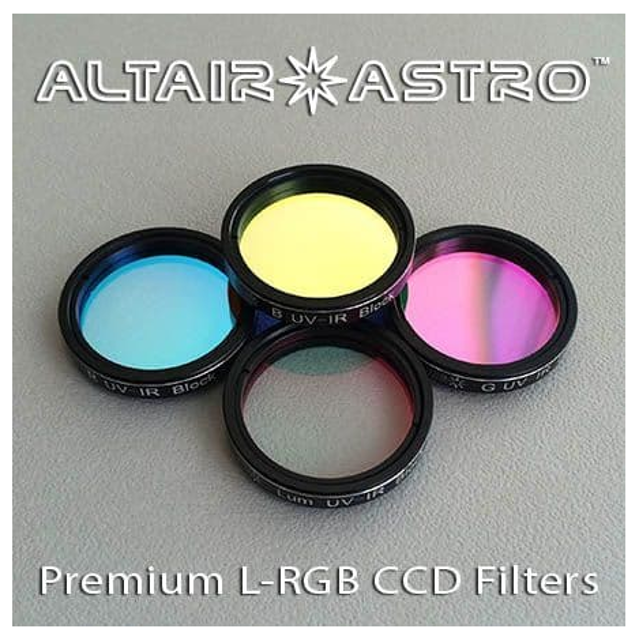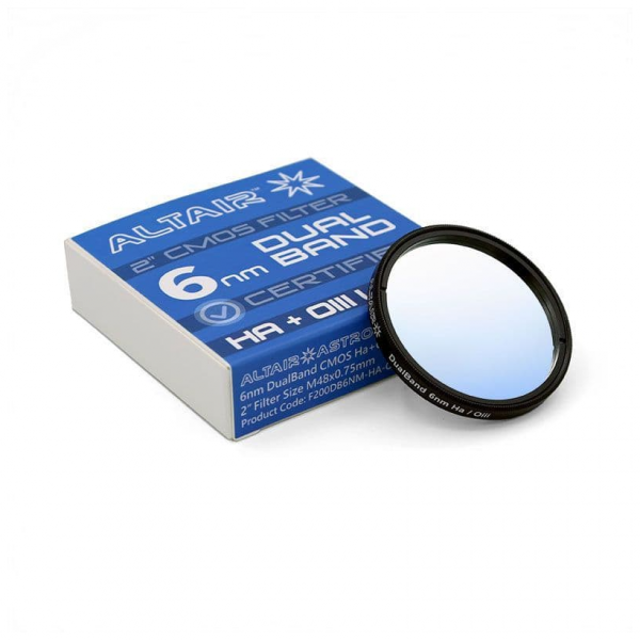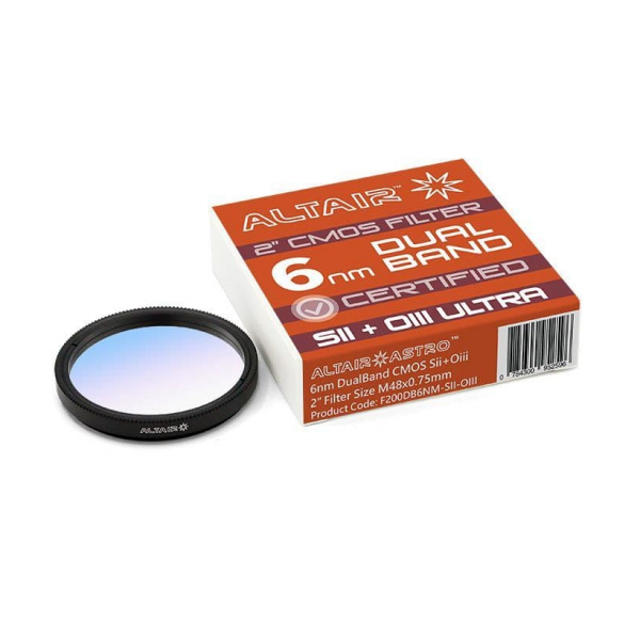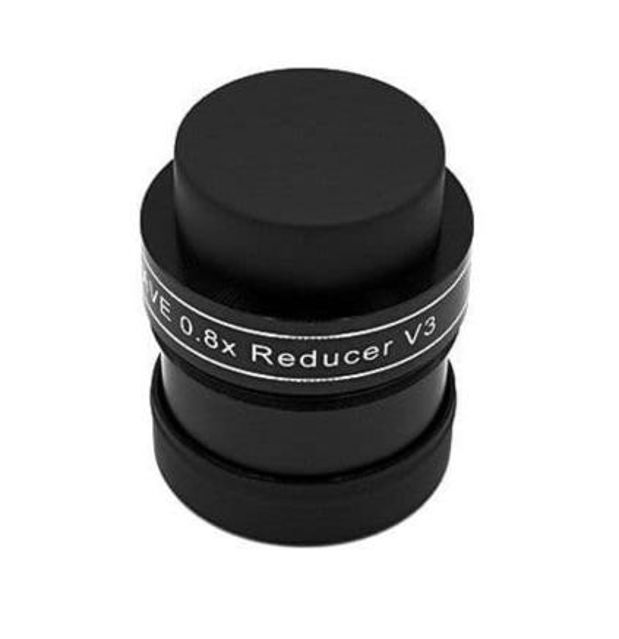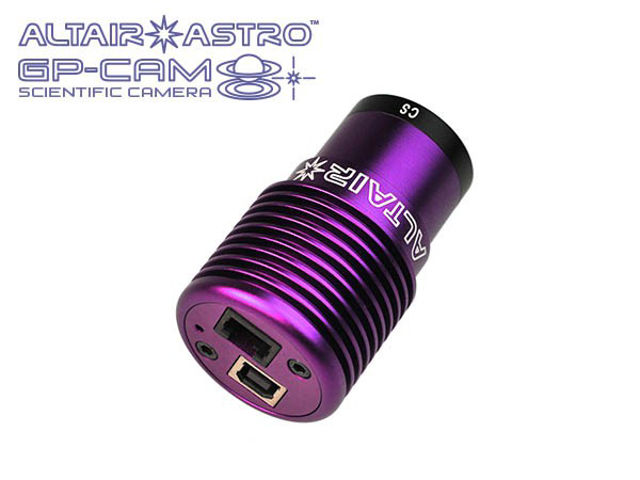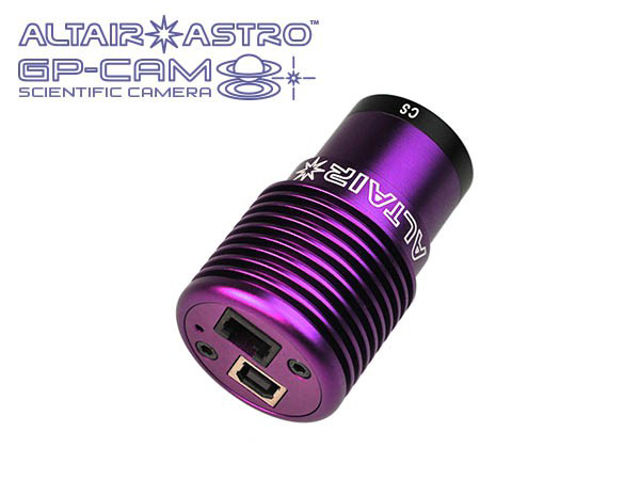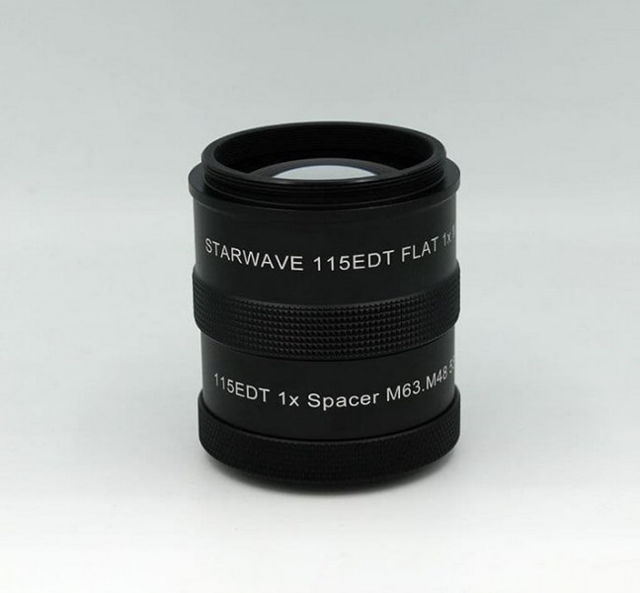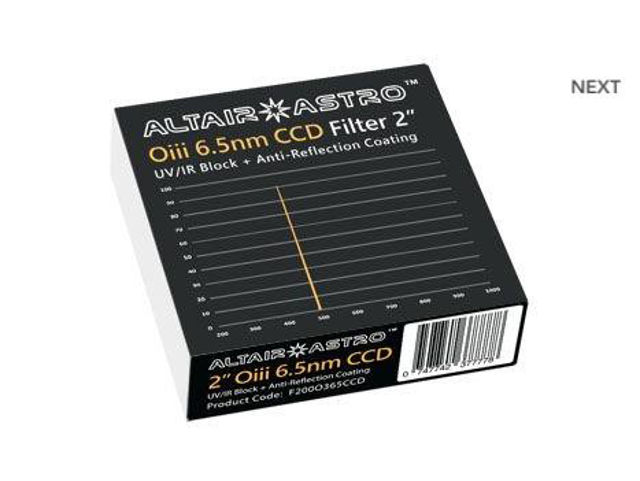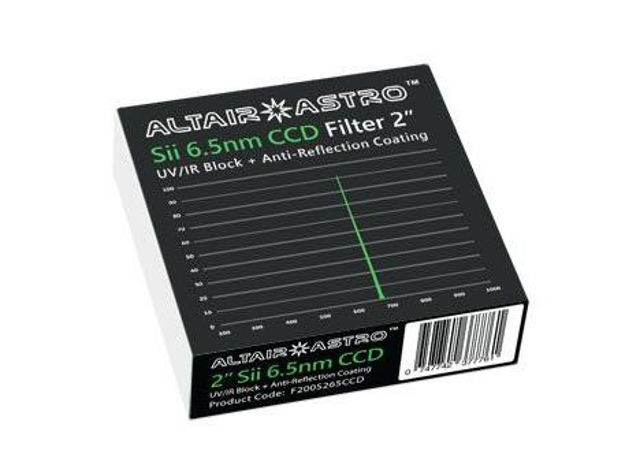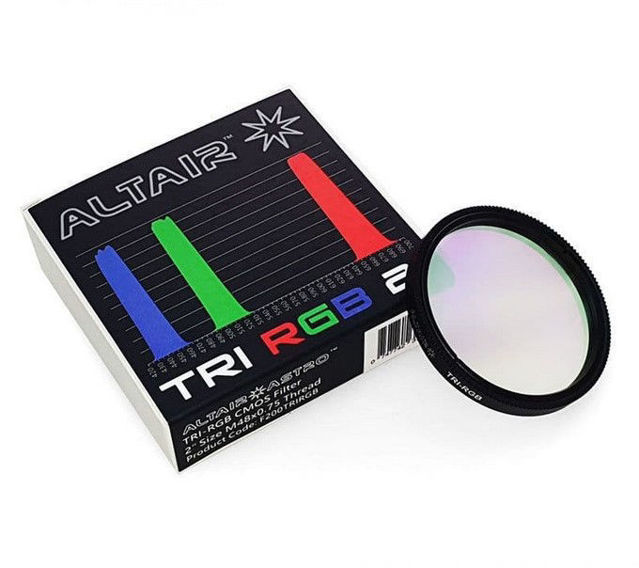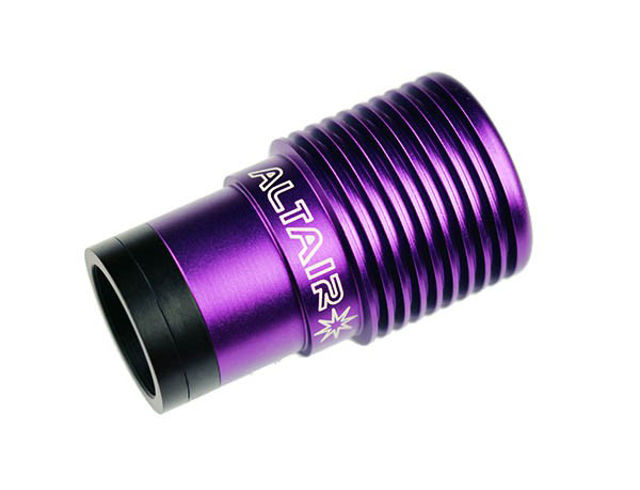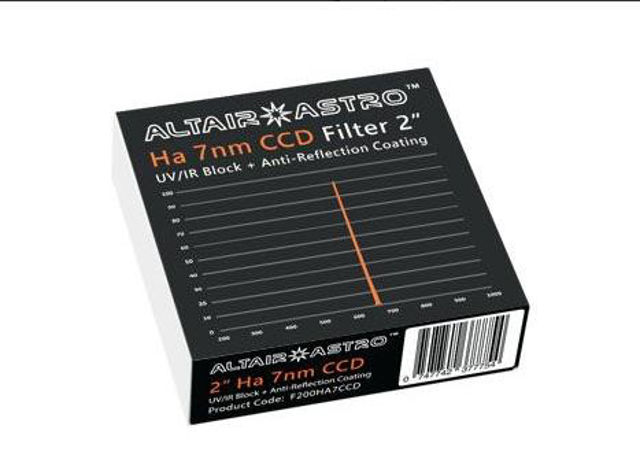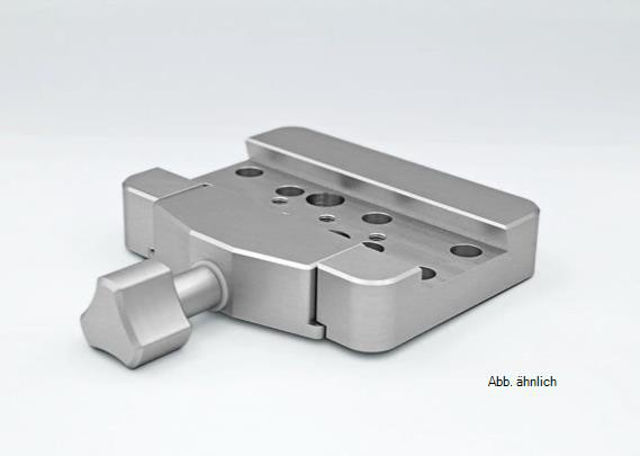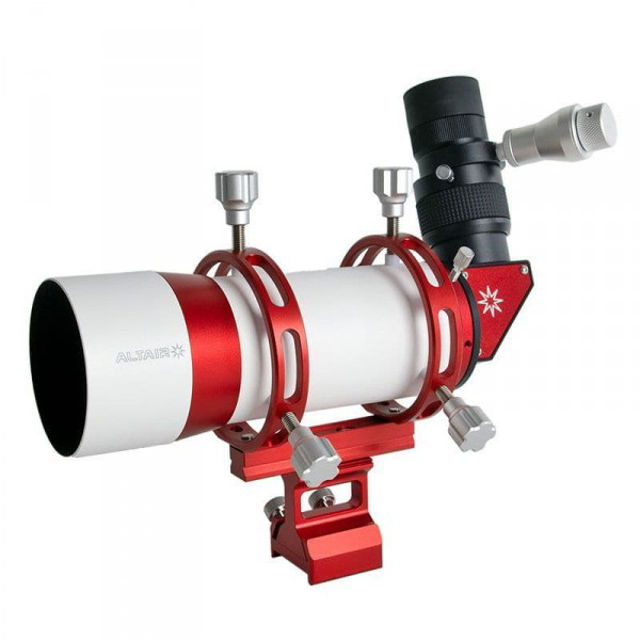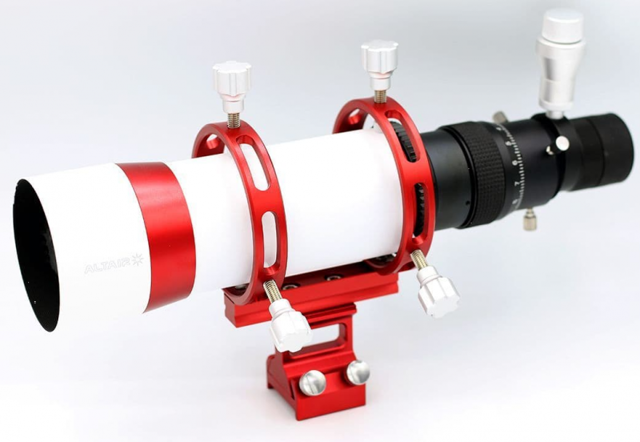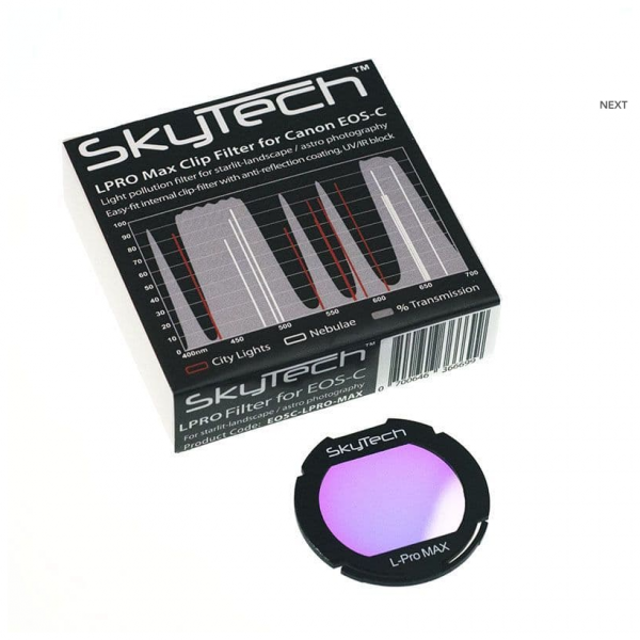Altair Astro

Altair Astro manufacturer of high quality astronomical accessories
Manufacturer in England of high quality accessories and distribution of CCD cameras. APM is a partially authorized dealer for Germany.
The Altair 395nm NUV filter selectively passes light of the two main Calcium wavelengths emitted by the sun: CA-K line at 393.37nm, and the CA-H line at 396.85nm.
199.00 € 179.00 €
Estimated delivery time : 2-4 weeks
Vixen HD Clamp for Sabre Mount
179.00 €
Estimated delivery time : 2-4 weeks
A premium dielectric coated diagonal which is small and compact with very high quality machining and a super-hard black anodised chassis and red anodised sides.
189.00 €
Estimated delivery time : 2-4 weeks
Altair Astro CNC pier adapter for many mounts, suitable for SkyShed pier and of course adaptable for other piers
- Suitable for iOptron CEM70, CEM60 and iEQ45
- Suitable for Skywatcher EQ6, AZ-EQ6, HEQ5, EQ5, EQ3
- Suitable for Celestron CGEM, CGEM-DX
- Suitable for LXD75 and many Vixen mounts
- Four countersunk holes for M8 screws - distance from the centre 64.5 mm
- Comes with four M8 stainless steel screws for attaching the adapter to the column
- Flat base for easy adaptation to columns and column stands
- Diameter 148 mm
- Height 30 mm
199.00 €
Estimated delivery time : 1-4 weeks
Product description Altair QuadBand is the new trend in light pollution filters for deep-sky imaging of emission nebulae with colour CMOS, CCD, and DSLR cameras. Altair V2 Filter Technology produces even better blocking of unwanted wavelengths, higher transmission, and no halos. The result is a better signal to noise ratio for imaging emission nebulae with a DSLR or CMOS Astro camera. The 35nm passband not only makes the QuadBand V2 compatible with fast focal ratio lenses and telescopes, but also allows visual use with a relatively small telescope in urban locations. Brighter emission nebulae can be observed in urban conditions with a darker background. This is the new QuadBand V2 Coating technology which includes: Anti-Halo coating on both surfaces to reduce reflection artefacts from reducers and camera lenses. Increased blocking of UV, IR and unwanted visual range wavelengths. UV OD7 (T0.00001%) Visual OD5 (T0.001%) and IR OD4 (T0.01%) for the ultimate in skyglow blocking. Higher transmission % of desired wavelengths Ttop 95% (Average 5% higher transmission of desired wavelengths). Ha and Oiii wavelengths at 35nm FWHM for with less tail-off to reduce unwanted light pollution. It's even compatible with fast scopes, like Altair F6 refractors which operate at F4.8 with reducers, and the F2 Celestron RASA and Hyperstar. Includes UVIR blocking for both modified and un-modified DSLR cameras, plus an anti-reflection coating to reduce halos as much as possible. Narrowband Bi-Colour imaging is a growing new trend in astrophotography, especially popular in light polluted areas, or for imaging in rural areas in moonlight. Now you can capture the two main emission nebulae bands at the same time, whilst suppressing light pollution, moonlight, and airglow. Capture more data in less time, and open up your imaging time window - even into the summer months. Altair QuadBand light pollution filters work by isolating the primary nebulae emission zones in the red and blue/green wavelengths, and separating them into two main "zones" with a wide separation for easy capture with a colour camera - all in one exposure! Not only is capture very convenient, but processing is easy too, thanks to the wide separation of the green/blue and red "zones". Light pollution control is extremely effective and LED light is also significantly reduced, thanks to the effects of Rayleigh scattering. Sensitive OSC or "One Shot Colour" CMOS cameras like the #Hypercam183C capture these wavelengths very efficiently, and allow them through the Bayer matrix. The filters also work with DSLRs (APS-C sensor size modified cameras are best, but normal ones will also work). When you have the complete stack of exposures, processing is relatively easy because of the large separation in colour. You can also use the Quad band and Tri-Band filters as a "super luminance filter" for imaging nebulae with Mono cameras. A quick overview of the Altair Filter family: QuadBand Filter - combines Sii AND Ha into a red zone, and H-beta + Oiii into a green/blue zone. (Recommended for moderate light pollution and skyglow, used with colour cameras). TriBand Filter - combines Ha into a red zone, and H-beta + Oiii into a green/blue zone. (Recommended for higher light pollution, used with colour cameras). DualBand Filter - separates Ha and Sii even more distinctly with even deeper blocking. (Recommended for severe light pollution such as within built-up areas such as cities. Used with colour cameras). NarrowBand mono camera filter - these isolate single bands, so you only capture one wavelength per filter such as Oiii or Ha or Sii, and they are mostly used with mono B&W astronomy cameras. Separate sets of exposures are required with each filter. Filter Specifications: QuadBand OSC filter CWL: 1st band, CWL495nm FWHM35nm 2nd band, CWL 660nm FWHM 35nm 1.85mm thick optical glass with 30 arc sec parallelism. UVIR Block and Anti-Reflection Coating. Delivered with: Filter
Item condition: new and original packed
Item condition: new and original packed
199.00 €
Estimated delivery time : 1-4 days
The Altair 395nm NUV filter selectively passes light of the two main Calcium wavelengths emitted by the sun: CA-K line at 393.37nm, and the CA-H line at 396.85nm. A specially developed multilayer interference coating results in transmission of approximately 75% at 395nm NUV wavelength. Bandwidth is approximately 7nm (FHWM), resulting in extremely high contrast in the selected wavelength with efficient blocking of unwanted wavelengths. Remaining UV and IR light between 400-1100nm is blocked at OD3 0.1%, and visible light between 400-700nm at OD4 0.01%. Imaging the sun: The filter is to be placed in front of a high speed CMOS video camera for displaying detail in the upper solar atmosphere, at the boundary between the photosphere and the chromosphere. Structures which cannot normally be seen by the human eye or cameras are revealed, including fast-evolving Ellerman bombs (micro-flares) and Plages, (bright networks near sunspots). Solar granulation is also enhanced, as well as umbral detail around sunspots. Imaging the planet Venus: The planet Venus also benefits greatly from higher contrast in the upper cloud layers, showing features normally invisible in white light. The high transmission allows fast frame rates. IMPORTANT: The 395nm wavelength is harmful and almost invisible to the eye, therefore the NUV filter is intended for photographic use ONLY. A pre-filter of at least OD3.8 is required to reduce radiation damage to the filter. A Herschel Wedge, such as the Altair Imaging-Ready Solar Wedge can be used, or solar film, provided the manufacturers instructions are followed correctly. Refractors are usually employed for solar imaging, however reflectors can be used, provided they have a large blocking filter over the front aperture (usually solar film or glass filter because Hershel Wedges cannot be used with reflector telescopes). Imaging requires a monochrome CMOS camera. A typical example with false colour and selective contrast processing is shown opposite (HDR filter, Photoshop). Specification: NUV transmission band, CWL 395nm FWHM 7nm Filter substrate: 1.85mm thick BK7 optically polished glass with 30 arc sec parallelism UVIR blocking: UV and IR light between 400-1100nm is blocked at OD3 (0.1%) Visible light blocking: Visible light between 400-700nm at OD4 (0.01%) Scope of Delivery: Filter Specifications: Cell: Aluminium Type: Interference filter Filter thread / size: 1.25"
Item condition: new and original packed
Item condition: new and original packed
199.00 €
Estimated delivery time : 1-4 days
Losmandy HD Clamp for Sabre Mount
229.00 € 206.00 €
Estimated delivery time : 1-2 days
Premium filter features:
- Batch-tested for consistency.
- High quality dichroic/dielectric coatings.
- Anti-Reflection coating to reduce star-halos - stackable.
- UV/IR block for imaging - star bloat reduction with refractors.
- Ultra-flat glass by Schott Germany.
- Precision CNC machined filter cell for strain-free mounting and freedom from tilt.
209.00 €
Estimated delivery time : 1-2 weeks
Altair DualBand 6nm Filter Features:
- Capture the two main emission nebulae bands at the same time, whilst suppressing light pollution, moonlight, and airglow.
- Acquire more data in less time, opening up your imaging window, even into the summer months when it isn't quite dark.
- If you have the 6nm Ha/Sii Ultra filter and the Sii/Ha version, you can capture twice the Oiii data in each imaging session and combine them for true SHO Hubble style imaging with a colour camera!
- Extremely steep bandpass yields maximum contrast in extreme light pollution: 6nm FHWM centred on 500.7nm Oiii wavelength, and 5.5nm FHWM centred on the 656.28nm Ha wavelength.
- Halo suppression anti-reflective coating.
- Can be used with One Shot Colour (OSC) CMOS or mono astronomical cameras for luminance data.
- Includes UVIR blocking for both modified and un-modified DSLR cameras, plus an anti-reflection coating for the ultimate in contrast.
- Best performance at focal ratios at F4.8 or slower, however can be used as fast as F3.6, with minimal contrast impact (conservative estimate - faster may be possible). Like any dichroic filter, contrast increases as focal ratio number increases. More info about light pollution filter performance and focal ratio here.
209.00 €
Estimated delivery time : 1-2 weeks
Altair DualBand 6nm Filter Features:
- Capture the two main emission nebulae bands at the same time, whilst suppressing light pollution, moonlight, and airglow.
- Acquire more data in less time, opening up your imaging window, even into the summer months when it isn't quite dark.
- If you have the 6nm Sii Oiii Ultra filter and the Ha Oiii version, you can capture twice the Oiii data in each imaging session and combine them for true SHO Hubble style imaging with a colour camera!
- Extremely steep bandpass yields maximum contrast in extreme light pollution: 6nm FHWM centred on 500.7nm Oiii wavelength, and 5.5nm FHWM centred on the 671.6nm Sii wavelength.
- Halo suppression anti-reflective coating.
- Can be used with One Shot Colour (OSC) CMOS or mono astronomical cameras for luminance data.
- Includes UVIR blocking for both modified and un-modified DSLR cameras, plus an anti-reflection coating for the ultimate in contrast.
- Best performance at focal ratios at F4.8 or slower, however can be used as fast as F3.6, with minimal contrast impact (conservative estimate - faster may be possible). Like any dichroic filter, contrast increases as focal ratio number increases. More info about light pollution filter performance and focal ratio here.
209.00 €
Estimated delivery time : 1-2 weeks
Altair Starwave v3 0.8x Reduces exposure time and gives a larger, flatter field with various refractors.
209.00 €
Estimated delivery time : 2-4 weeks
Very high sensitivity in the far red / NIR region makes the GPCAM2 224c especially good for solar imaging with the Daystar Quark other Hydrogen Alpha filters.
219.00 €
Estimated delivery time : 1-4 weeks
Altair QuadBand is the new trend in light pollution filters for deep-sky imaging of emission nebulae with colour CMOS, CCD, and DSLR cameras. Altair V2 Filter Technology produces even better blocking of unwanted wavelengths, higher transmission, and no halos. The result is a better signal to noise ratio for imaging emission nebulae with a DSLR or CMOS Astro camera. The 35nm passband not only makes the QuadBand V2 compatible with fast focal ratio lenses and telescopes, but also allows visual use with a relatively small telescope in urban locations. Brighter emission nebulae can be observed in urban conditions with a darker background. This is the new QuadBand V2 Coating technology which includes: Anti-Halo coating on both surfaces to reduce reflection artefacts from reducers and camera lenses. Increased blocking of UV, IR and unwanted visual range wavelengths. UV OD7 (T0.00001%) Visual OD5 (T0.001%) and IR OD4 (T0.01%) for the ultimate in skyglow blocking. An order of magnitude better than foreign filters. Higher transmission % of desired wavelengths Ttop 95% (Average 5% higher transmission of desired wavelengths). Ha and Oiii wavelengths at 35nm FWHM for with less tail-off to reduce unwanted light pollution. It's even compatible with fast scopes, like Altair F6 refractors which operate at F4.8 with reducers, and the F2 Celestron RASA and Hyperstar. Includes UVIR blocking for both modified and un-modified DSLR cameras, plus an anti-reflection coating to reduce halos as much as possible. Narrowband Bi-Colour imaging is a growing new trend in astrophotography, especially popular in light polluted areas, or for imaging in rural areas in moonlight. Now you can capture the two main emission nebulae bands at the same time, whilst suppressing light pollution, moonlight, and airglow. Capture more data in less time, and open up your imaging time window - even into the summer months. Altair QuadBand light pollution filters work by isolating the primary nebulae emission zones in the red and blue/green wavelengths, and separating them into two main "zones" with a wide separation for easy capture with a colour camera - all in one exposure! Not only is capture very convenient, but processing is easy too, thanks to the wide separation of the green/blue and red "zones". Light pollution control is extremely effective and LED light is also significantly reduced, thanks to the effects of Rayleigh scattering. Sensitive OSC or "One Shot Colour" CMOS cameras like the #Hypercam183C capture these wavelengths very efficiently, and allow them through the Bayer matrix. The filters also work with DSLRs (APS-C sensor size modified cameras are best, but normal ones will also work). When you have the complete stack of exposures, processing is relatively easy because of the large separation in colour. You can also use the Quad band and Tri-Band filters as a "super luminance filter" for imaging nebulae with Mono cameras. A quick overview of the Altair Filter family: QuadBand Filter - combines Sii AND Ha into a red zone, and H-beta + Oiii into a green/blue zone. (Recommended for moderate light pollution and skyglow, used with colour cameras). TriBand Filter - combines Ha into a red zone, and H-beta + Oiii into a green/blue zone. (Recommended for higher light pollution, used with colour cameras). DualBand Filter - separates the red Ha and blue Oiii channels even more distinctly with even deeper blocking. (Recommended for severe light pollution such as within built-up areas such as cities. Used with colour cameras). NarrowBand mono camera filter - these isolate single bands, so you only capture one wavelength per filter such as Oiii or Ha or Sii, and they are mostly used with mono B&W astronomy cameras. Separate sets of exposures are required with each filter. Filter Specifications: 1st band, CWL495nm FWHM35nm 2nd band, CWL 660nm FWHM 35nm 1.85mm thick optical glass with 30 arc sec parallelism. UVIR Block and Anti-Reflection Coating. Scope of Delivery: Filter 2"
Item condition: new, but not original packed
Item condition: new, but not original packed
226.00 €
Estimated delivery time : 1-4 days
Very high sensitivity in the far red / NIR region makes the GPCAM2 AR0130 especially good for solar imaging with the Daystar Quark other Hydrogen Alpha filters.
229.00 €
Estimated delivery time : 1-4 weeks
This field flattener is designed to work with the Altair Astro Starwave Series 115EDT Triplet APO.
239.00 €
Estimated delivery time : 2-4 weeks
The Altair Astro Premium Oiii 6.5nm filter is designed for astro imaging of nebulae with Mono CCD or CMOS cameras, blocking light pollution by cutting out the light pollution wavelengths. The filter blocks UV IR and has an anti-reflection AR coating.
255.00 €
Estimated delivery time : 2-4 weeks
The Altair Astro Premium Sii 6.5nm filter is designed for astro imaging of nebulae with Mono CCD or CMOS cameras, blocking light pollution by cutting out the light pollution wavelengths. The filter blocks UV IR and has an anti-reflection AR coating.
255.00 €
Estimated delivery time : 2-4 weeks
This filter was developed to suppress light pollution for colour and monochrome cameras and offers more balanced RGB colours.
- ltair TRI-RGB is great for broadband objects such as mixed emission / reflection nebulae, comets, dust clouds and galaxies, but it also allows the major emission nebulae lines through. It covers both broadband AND narrowband targets.
- TRI-RGB complements the Altair TriBand and DualBand filters by adding star colours.
- TRI-RGB and works with fast or slow focal ratio telescopes and camera lenses.
- TRI-RGB is not only for light pollution control. It works very well under dark skies too by enhancing colour purity, airglow and reducing channel crossover in colour CMOS and DSLR cameras.
- Although primarily intended for colour cameras, TRI-RGB can be used for a cleaner luminance channel with a mono camera.
- High transmission peaks with steep sides enhance contrast, together with almost total suppression of unwanted light, at OD4/5 (0.01%~0.001%) over the majority of unwanted visual wavelengths.
279.00 € 259.00 €
Estimated delivery time : 1-2 weeks
The Altair GPCAM2 290C Colour camera has the sought after Sony Exmor IMX290 CMOS sensor, with high sensitivity, and extremely low read noise
259.00 €
Estimated delivery time : 1-4 weeks
The Altair Astro Premium 7nm Ha filter is designed for astro imaging of nebulae with Mono CCD or CMOS cameras, blocking light pollution by cutting out the light pollution wavelengths.
259.00 €
Estimated delivery time : 2-4 weeks
Universal HD Clamp for Sabre Mount
269.00 €
Estimated delivery time : 2-4 weeks
The Altair Astro 60mm finder also has many more features than your average finder scope:
- This finder is right angled for more comfort, with a corrected field (i.e. not mirror-reversed like other finders), so objects actually match their orientation in your star chart.
- The focuser can also be rotated 360° and locked in seconds (requiring some re-alignment afterwards). The 10mm larger objective and a little extra power compare to 8x50 finders, yet has almost the same size and weight.
- The included quick-release finder base has 4x 4mm slotted holes in the base allowing you to fit it to most telescopes on the market. (The mini-dovetail wedge on the bracket will fit any GSO or Skywatcher telescope directly in fact but we suggest you use the included base if it fits the tube, because it has 2x clamping screws, for better alignment).
- The CNC machined bracket is light yet rigid to keep alignment. Nylon tipped screws do not damage the durable high quality and moisture resistant powder coated aluminium tube.
- All objective lenses are anti-reflection coated and the tube and dewshield are internally blackened to increase contrast. The included illuminator has a variable setting, which illuminates the cross hairs in the eyepiece. The included eyepiece has a dark field illuminated cross-hair, so you can easily see it glowing faintly against the background sky, an upgrade for standard finders with dark cross-hairs.
- The high quality 1.25 FMC illuminated eyepiece has good eye relief for glasses-wearers, and a wide field of view. It has a side-port to screw in the included variable darkfield illuminated reticule, and the finder can be very easily focused, using the included helical focuser integrated with the prism diagonal.
269.00 €
Estimated delivery time : 2-4 weeks
Fast 60mm viewfinder with helical focuser and tube clamps
Key data
- 60mm aperture
- 225mm focal length at a focal ratio of f/3.75
- Illuminated crosshair eyepiece
- Helical focuser (the image does not rotate when focusing)
- Complete tube clamp set with mounting material
- Can also be used as a guidescope
269.00 €
Estimated delivery time : 2-4 weeks
Why choose a SkyTech Clip-Filter?
- It can be inserted or removed in seconds. All lens functions (focus, preview screen, image stabilization) work as usual.
- If you have a telescope with short space between reducer/flattener and camera and filter wheel, a clip filter is the solution.
- It protects your sensor from dust build-up during long exposures.
269.00 €
Estimated delivery time : 1-2 weeks
